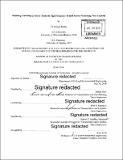Modeling crowding levels by trains in high-frequency transit service operating near capacity
Author(s)
Miller, Eli Samuel.
Download1128186162-MIT.pdf (11.21Mb)
Other Contributors
Massachusetts Institute of Technology. Department of Civil and Environmental Engineering.
Advisor
Jinhua Zhao, John P. Attanucci and Gabriel E. Sánchez-Martínez.
Terms of use
Metadata
Show full item recordAbstract
Measuring rail system crowding is important to transit agencies. Crowding data has implications for safety, operations control, service planning, performance measurement, and customer information. This paper proposes a bi-level regression model that transit agencies can use to estimate the number of passengers left behind on a platform by high frequency trains operating at capacity. Inputs to the model include the number of passenger arrivals between trains and train departure times, which are derived from automatic fare collection and vehicle location data. The data are used to calculate the proposed measure of cumulative capacity shortage, which is shown to have high correlation with the number of passengers left behind. A bi-level regression approach is introduced and applied to calibrate the model parameters based on manual counts of passengers left behind. A case study using data from the Chicago Transit Authority's Blue Line demonstrates promising results, with an adjusted coefficient of determination of 0.81. The model could be used for post-hoc analysis of crowding performance or, in the context of real-time operations monitoring, for near-term predictions of passengers left behind. Keywords: platform crowding, train capacity, passengers left behind, automatically collected data Measuring train and platform loads is important for transit agencies. Load data can be used by agencies for service planning, operations control, performance measurement, and provision of information to passengers. These data also have safety implications for stations where excessive platform loads pose a safety hazard. The model proposed in this paper estimates train and platform loads on passenger rail systems operating at or below capacity. Inputs to the model include train departure times and passenger origin-destination and station entry times. These data are used to load passengers from each platform onto the train up to the capacity of the train (also determined by the model), leaving any additional passengers behind on the platform. The model was calibrated using data from the Chicago Transit Authority's Blue Line. Two applications for train and platform load data are explored in this paper: a) a performance indicator that tracks passengers affected by uncomfortable train loads and b) an operations control strategy that reduces total passenger time in the system. Keywords: platform crowding, train capacity, passengers left behind, platform load, train load, automatically collected data
Description
Thesis: S.M. in Transportation, Massachusetts Institute of Technology, Department of Civil and Environmental Engineering, 2018 Cataloged from PDF version of thesis. Includes bibliographical references.
Date issued
2018Department
Massachusetts Institute of Technology. Department of Civil and Environmental EngineeringPublisher
Massachusetts Institute of Technology
Keywords
Civil and Environmental Engineering.